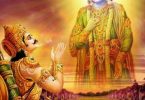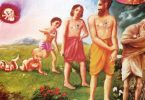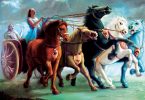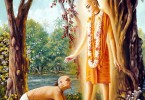Question: There are various scriptural references indicating the Yuga Avatāra for Dvāpara Yuga is Krsna Himself. Here are two examples.
Tattva Sandarbha Text 1: “The white incarnation was Lord Hamsa, the yugävatära for Satya-yuga; the red incarnation was Lord Yajïa, the yugävatära for Tretä-yuga; and dark-blue Krsna appeared in Dväpara-yuga.”
CC Madhya 20.337-338 (wherein Yuga Avatāras are being explained): “In Dväpara-yuga the Personality of Godhead appears in a blackish hue. He is dressed in yellow, He holds His own weapons, and He is decorated with the Kaustubha jewel and the mark of Çrévatsa. That is how His symptoms are described.’
First, is it a correct understanding that commonly Yuga Avatāras appear towards the beginning of each of the four yugas, to teach by example the means of achieving perfection for that age/yuga?
Second, if so, how to understand the fact that the Yuga Avatāra for Dvāpara Yuga appeared towards the end of the Yuga?
Answer by Romapada Swami:
The yuga-avatāra facilitates the learning of the yuga-dharma. Consequently – while it is common for the Yuga Avatāra to appear early in each yuga, it is NOT a requirement that the Yuga Avatāra appears towards the beginning of the Yuga, to teach by example the Yuga Dharma.
In other Dvāpara yugas, the Yuga Avatāra doesn’t wait till the very end. It is in this one that the specialty occurs.
The tantras and āgama literatures are already existing in Dvāpara, to teach the general populace. For example, sankirtana was already in the śāstra even before Mahāprabhu appeared; Mahāprabhu’s appearance facilitated the yuga-dharma.
Here are two details from scripture which provide us with an expanded understanding of the Yuga Dharma for Dvāpara Yuga.
-Deity worship, the Yuga Dharma for Dvāpara Yuga, means to serve the Lord — “Like a king”. Sri Jiva Goswami says in his commentary to Bhakti-rasāmṛta-sindhuḥ — “rājā iva sevā — deity worship is to serve the Lord like a king.” (Commentary to Bhakti-rasāmṛta-sindhuḥ 1.2.140)
The same is confirmed in SB Canto 11.
(SB 11.5.28) “My dear King, in Dvāpara-yuga men who desire to know the Supreme Personality of Godhead, who is the supreme enjoyer, worship Him in the mood of honoring a great king, following the prescriptions of both the Vedas and tantras.”
(SB 11.5.29-30 purport) Śrīla Jīva Gosvāmī explains that although Lord Kṛṣṇa appeared at the end of Dvāpara-yuga, great sages chanted this verse from the beginning of that age in expectation of His appearance.
Krishna appeared as the king of Dvāraka and gave all citizens the opportunity to worship him directly as a king.
-Also…
dvāpare śuka-patrābhaḥ
kalau śyāmaḥ prakīrtitaḥ
In other Dvāpara yugas, he is green as the feather of a parrot and in those kali-yugas, he appears in dark complexion. — (Viṣṇu-dharmottara-purāṇa)







